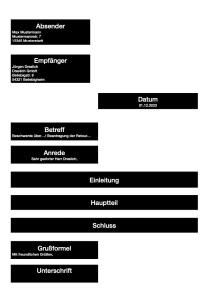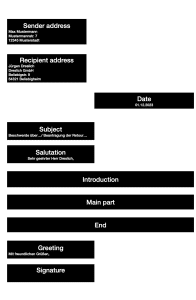Die Prüfungsaufgabe Beschwerdebrief B2 telc ist ein wichtiger Bestandteil der B2 Deutsch-Prüfung. In diesem Prüfungsteil wird deine Fähigkeit beurteilt, auf eine problematische Situation angemessen zu reagieren und eine formelle Beschwerde in schriftlicher Form zu verfassen. Ein Beschwerdebrief kann viele verschiedene Gründe haben, z. B. schlechter Kundenservice, mangelnde Produktqualität oder unzureichende Arbeitsbedingungen. In der Telc B2 Deutsch Prüfung wird den Prüflingen eine Situation vorgegeben, auf die sie reagieren müssen. In diesem Artikel erfährst du, was du beim Schreiben eines Beschwerdebriefs B2 telc beachten musst und wie du dich am besten vorbereitest.
Note: You can find this post in English below ⬇
Du möchtest dich mit prüfungsnahen Übungen auf deine Deutsch B2 Prüfung vorbereiten? Kein Problem!
Unser Prüfungstrainer bietet dir eine umfassende Vorbereitung auf deine Deutsch B2 Prüfung mit vielen prüfungsnahen Übungen zu den vier Prüfungsteilen “Lesen”, “Hören”, “Schreiben” und “Sprechen”. Schau doch einfach mal rein und beginne jetzt mit der optimalen Vorbereitung auf deine Prüfung!
Falls du zuerst unverbindlich testen möchtest, trage dich hier ein. Wir senden dir innerhalb einer Minute kostenlose prüfungsnahe Aufgaben für die Deutsch B2 Prüfung per E-Mail zu.
Worum geht es?
Beim Schreiben eines Beschwerdebriefs geht es darum, eine Beschwerde in schriftlicher Form klar und präzise zu formulieren. Im Gegensatz zur B1-Prüfung ist der Umfang des Beschwerdebrief B2 telc größer – in mindestens 150 Wörtern musst du deine Fähigkeiten in der deutschen Sprache unter Beweis stellen. Um einen professionellen Eindruck zu hinterlassen, solltest du natürlich keine größeren Grammatik- oder Rechtschreibfehler in deinem Brief haben. Außerdem kannst du mit dieser Aufgabe zeigen, dass du über einen umfangreichen Wortschatz verfügst. Es ist wichtig, dass der Brief eine klare Struktur hat und dass die Beschwerde selbst höflich, aber bestimmt formuliert ist. Der Beschwerdebrief B2 telc sollte alle wichtigen Details enthalten und sich auf konkrete Ereignisse beziehen, um die Situation besser beschreiben zu können.
Deine Vorbereitung auf den Untertest “Beschwerdebrief B2 telc”
Um dich auf den Untertest “Beschwerdebrief B2 telc” vorzubereiten, solltest du deine Fähigkeit verbessern, formell und präzise zu schreiben. Dabei solltest du dich auf die Verwendung von formalen Ausdrücken und Sätzen konzentrieren und sicherstellen, dass deine Gedanken klar und präzise ausgedrückt werden. Eine gute Vorbereitung kann auch darin bestehen, sich mit den verschiedenen Arten von Beschwerdebriefen vertraut zu machen und zu verstehen, welcher Aufbau und welche Formulierungen sich für welche Art von Beschwerdebrief am besten eignen. Es ist auch hilfreich, wenn du in deiner Vorbereitungszeit bereits einige Beschwerdebriefe geschrieben hast. Das kannst du zum Beispiel mit unserem Prüfungstrainer üben!
Mit gutem Leseverständnis das Schreiben verbessern
Neben der Vorbereitung auf den Untertest solltest du auch deine Lesefähigkeiten verbessern, um sicherzustellen, dass du die vorgegebene Situation vollständig verstehst. Durch häufiges Lesen deutscher Texte wirst du deine Fähigkeit verbessern, relevante Informationen aus Texten zu extrahieren und sicherstellen, dass du alle wichtigen Details in deinen Beschwerdebrief B2 telc aufnehmen kannst.
Grammatik und Rechtschreibung
Übe gezielt Grammatikregeln und Rechtschreibung, um dich auf die B2 Deutschprüfung vorzubereiten. So kannst du sicherstellen, dass du die Unterschiede zwischen verschiedenen Konjunktionen, Präpositionen und Artikeln verstehst und die deutsche Sprache sicher anwenden kannst.
Aufbau eines Briefes für den Untertest “Beschwerdebrief B2 telc”
Ein Brief ist in der Regel immer gleich aufgebaut. Er besteht in der Regel aus verschiedenen Elementen, die in einer bestimmten Reihenfolge angeordnet sind. Der Aufbau eines Beschwerdebrief B2 telc kann je nach Art und Zweck variieren, aber im Allgemeinen gibt es einige grundlegende Elemente, die in fast jedem Brief enthalten sind. Welche das sind, erfährst du hier.
1. Absenderadresse
Die Absenderadresse steht in der linken oberen Ecke des Beschwerdebrief B2 telc. Sie ist die Adresse der Person, die den Brief schreibt. Die Absenderadresse wird auch Briefkopf oder Briefbogen genannt.
2. Datum
Das Datum steht in der rechten oberen Ecke des Beschwerdebrief B2 telc unter der Absenderadresse. Das Datum ist wichtig, da es dem Empfänger hilft, den Brief zeitlich einzuordnen.
3. Empfängeradresse
Die Adresse des Empfängers steht unter dem Datum in der linken oberen Ecke des Briefes. Dies ist die Adresse der Person oder Organisation, an die der Brief gerichtet ist.
4. Anrede
Die Anrede steht direkt unter der Empfängeradresse. Sie ist die Anrede der Person, an die der Brief gerichtet ist. Je nach Beziehung zwischen Absender und Empfänger kann die Anrede variieren.
5. Betreffzeile
Die Betreffzeile steht direkt unter der Anrede. Sie fasst kurz zusammen, worum es im Brief geht.
6. Einleitung
Die Einleitung beginnt direkt unter der Betreffzeile und sollte den Leser begrüßen und den Zweck des Schreibens erläutern.
7. Hauptteil: Beschreibung der Situation
Der Hauptteil des Briefes enthält die eigentliche Nachricht, die du übermitteln möchtest. Er sollte alle wichtigen Informationen enthalten.
8. Schluss
Zusammenfassung
Eine Zusammenfassung am Ende eines Beschwerdebriefs ist eine kurze und prägnante Zusammenfassung der wichtigsten Punkte und Argumente, die in dem Brief vorgebracht wurden. Sie dient dazu, dem Empfänger des Schreibens einen schnellen Überblick über die wichtigsten Beschwerdepunkte zu geben und seine Aufmerksamkeit auf die Hauptanliegen des Beschwerdeführers zu lenken.
Forderungen und Verbesserungsvorschläge
Am Ende des Schreibens sollte eine Forderung formuliert werden, die sich aus der Beschwerde ergibt. Auf diese Weise erhält der Empfänger des Beschwerdebriefs eine klare Vorstellung davon, was von ihm erwartet wird. Indem du eine Forderung formulierst, stellst du sicher, dass die Beschwerde nicht als bloße Rückmeldung, sondern als Aufforderung zur Veränderung verstanden wird.
Indem du Verbesserungsvorschläge machst, trägst du aktiv zur Lösung des Problems bei. Es zeigt, dass du nicht nur auf ein Problem hinweist, sondern dir auch Gedanken darüber gemacht hast, wie es gelöst werden kann.
9. Bitte um Antwort
Am Ende eines Beschwerdebriefes kann eine “Bitte um Antwort” formuliert werden, um sicherzustellen, dass der Empfänger des Briefes auf die Beschwerde reagiert. Die “Bitte um Antwort” ist eine freundliche Aufforderung an den Empfänger, dem Beschwerdeführer innerhalb einer bestimmten Frist zu antworten. Ein Beispiel für eine Bitte um Antwort am Ende eines Beschwerdebriefs könnte wie folgt lauten:
“Ich bitte Sie höflich, mir innerhalb der nächsten 14 Tage eine Rückmeldung zu geben und mir mitzuteilen, welche Maßnahmen Sie ergreifen werden, um das von mir geschilderte Problem zu lösen.” “Ich danke Ihnen im Voraus für Ihre Aufmerksamkeit und Ihr Engagement bei der Lösung dieser Angelegenheit.”
10. Grußformel
Die Grußformel wird unter dem Schluss platziert und dient dazu, den Brief auf eine höfliche Weise zu beenden. Hierbei gibt es verschiedene Standardformulierungen wie “Mit freundlichen Grüßen” oder “Hochachtungsvoll”.
11. Unterschrift
Die Unterschrift wird direkt unter der Grußformel platziert und sollte den vollständigen Namen des Absenders enthalten.
Den Aufbau eines Beschwerdebriefes kannst du zudem in der folgenden Abbildung nachschauen:

Beschwerdebrief schreiben in der B2 telc Prüfung Deutsch: Tipps und Tricks
Wenn du einen Beschwerdebrief B2 telc schreiben musst, gibt es einige wichtige Dinge, die du beachten solltest. Hier sind einige Tipps, die dir beim Beschwerdebrief schreiben helfen können:
1. Zielgruppe
Überlege, wer der Empfänger des Beschwerdebrief B2 telc sein wird. Passt die Wortwahl und der Ton zu der Zielgruppe?
2. Klarheit
Achte darauf, dass deine Beschwerde klar und präzise formuliert ist. Vermeide es, vom Thema abzuschweifen und konzentriere dich auf das Wesentliche.
3. Begründung
Gib eine klare Begründung für deine Beschwerde. Lege dazu dar, was genau das Problem ist, wann und wo es aufgetreten ist und wie es dich beeinflusst hat. Eine Möglichkeit ist es, die Erwartungen in einen Vergleich zu der Realität zu setzen und daraus zu schlussfolgern, warum es zur Beschwerde kommt.
4. Biete Lösungsvorschläge an
Schlage mögliche Lösungen für das Problem vor. Es ist wichtig, dass du dabei konstruktiv bist und beweist, dass du an einer Lösung interessiert bist. Dabei solltest du natürlich höflich und respektvoll bleiben, auch wenn du dich beschwerst. Vermeide unbedingt beleidigende oder aggressive Sprache. Das ist unprofessionell und wird dir keine Punkte in deiner Prüfung einbringen. Auch im echten Leben werden Beschwerden besser angenommen, wenn diese sachlich und höflich vorgetragen wurde.
5. Länge
Halte den Beschwerdebrief B2 telc möglichst kurz und prägnant. Ein zu langer Brief kann schnell unübersichtlich und schwer verständlich werden. Dein Brief sollte also insgesamt mindestens 150 und nicht mehr als 225 Wörter umfassen.
Unterschied zur Email
Je nachdem an welchem Standort du den B2 Deutschtest ablegst, kann bei der Aufgabe eine “Beschwerde zu verfassen” auch die Form einer Email verlangt werden. Emails werden in der Regel im Gegensatz zu Briefen etwas umgangssprachlicher formuliert und sind weniger formell.
Zusätzlich gibt es einige weitere wichtige Aspekte, die beim Schreiben einer Email anders sind als beim Schreiben eines Briefes:
- In einer Email kannst du auf den Briefkopf, die Absenderadresse, die Empfängeradresse und das Datum verzichten. Diese sind für das Verfassen einer Beschwerdeemail nicht relevant.
- Ein Brief hat tendenziell eine längere Länge als eine Email, da es mehr Informationen und Details enthält. Eine Email hingegen sollte in der Regel prägnanter und auf den Punkt gebracht sein.
- Die Sprache in einem Brief ist tendenziell formeller und höflicher als in einer Email. Ein Brief wird oft in einem höflichen Ton verfasst, der dem Empfänger Respekt zeigt und eine professionelle Atmosphäre schafft. Eine Email kann informeller und umgangssprachlicher sein, sollte jedoch weiterhin einen professionellen Eindruck machen.
Fazit
Das Verfassen eines wirksamen Beschwerdebrief B2 telc ist eine wichtige Fähigkeit, die du beherrschen solltest, da sie dazu beitragen kann, Probleme schnell und effektiv zu lösen und sicherzustellen, dass deine Anliegen gehört werden. Um einen erfolgreichen Beschwerdebrief B2 telc zu verfassen, solltest du sachlich, präzise und höflich sein und eine klare Beschreibung des Problems sowie mögliche Lösungen oder Forderungen benennen. Viele Übungsaufgaben für das Beschwerdebrief B2 telc schreiben findest du in unserem Prüfungstrainer. Wir wünschen dir viel Erfolg bei deiner Deutsch B2-Prüfung!
Das könnte dich auch interessieren:
Deutsch B2 Prüfung Goethe-Institut: Jetzt online vorbereiten!
Berufswahl: Mit diesen 5 Tipps findest du den Job, der perfekt zu dir passt!
Studierfähigkeitstest 2023 üben – Online Testtrainer

Complaint letter B2 telc exam – practise online now!
The examination task Complaint Letter B2 telc is an important part of the B2 German examination. This part of the exam assesses your ability to react appropriately to a problematic situation and to write a formal complaint. A letter of complaint can have many different reasons, such as poor customer service, poor product quality or inadequate working conditions. In the Telc B2 German exam, candidates are given a situation to respond to. In this article, you will find out what you need to consider when writing a B2 telc letter of complaint and how best to prepare.
Would you like to prepare for your German B2 exam with exam-related exercises? No problem!
Our exam trainer offers you comprehensive preparation for your German B2 exam with many exam-related exercises for the four exam sections “Reading”, “Listening”, “Writing” and “Speaking”. Just take a look and start preparing for your exam now!
If you would like to try it out first without obligation, register here. We will send you free exam-related tasks for the German B2 exam by e-mail within one minute.
What is it about?
Writing a letter of complaint is about formulating a complaint clearly and precisely in written form. In contrast to the B1 exam, the scope of the letter is larger – in at least 150 words you have to demonstrate your skills in the German language. To make a professional impression, you should not have any major grammatical or spelling mistakes in your letter. In addition, you can use this task to show that you have an extensive vocabulary. It is important that the letter has a clear structure and that the complaint itself is worded politely but firmly. The letter should contain all the important details and refer to concrete events to better describe the situation.
Your preparation for the subtest “Complaint letter B2 telc
To prepare for the subtest “Letter of complaint B2 telc”, you should improve your ability to write formally and precisely. You should focus on the use of formal expressions and sentences and make sure that your thoughts are expressed clearly and precisely. Good preparation can also involve familiarising yourself with the different types of letters of complaint and understanding which structure and phrasing are best suited to which type of letter. It is also helpful if you have already written a few letters of complaint in your preparation time. You can practise this with our exam trainer, for example!
Improve your writing with good reading comprehension
In addition to preparing for the subtest, you should also improve your reading skills to ensure that you fully understand the given situation. By reading German texts frequently, you will improve your ability to extract relevant information from texts and ensure that you can include all the important details in your letter.
Grammar and spelling
Practise grammar rules and spelling to prepare for the B2 German exam. This will ensure that you understand the differences between various conjunctions, prepositions and articles and can use the German language with confidence.
Structure of a letter for the subtest “Beschwerdebrief B2 telc”
As a rule, a letter is always structured in the same way. It usually consists of different elements which are arranged in a certain order. The structure of a letter can vary depending on its type and purpose, but in general there are some basic elements that are included in almost every letter. You can find out what these are here.
1. sender address
The sender’s address is in the top left-hand corner of the letter. It is the address of the person writing the letter. The sender’s address is also called letterhead or letterhead.
2. date
The date is in the top right-hand corner of the letter under the sender’s address. The date is important because it helps the recipient to time the letter.
3. recipient’s address
The recipient’s address is below the date in the top left corner of the letter. This is the address of the person or organisation to whom the letter is addressed.
4. salutation
The salutation is directly below the recipient’s address. It is the salutation of the person to whom the letter is addressed. The salutation may vary depending on the relationship between sender and recipient.
5. Subject line
The subject line is directly below the salutation. It briefly summarises what the letter is about.
6. introduction
The introduction begins directly below the subject line and should welcome the reader and explain the purpose of the letter.
7. main body: description of the situation
The body of the letter contains the actual message you want to convey. It should contain all the important information.
8. conclusion
Summary
A summary at the end of a letter of complaint is a short and concise summary of the main points and arguments made in the letter. It serves to give the recipient of the letter a quick overview of the main points of the complaint and to focus his/her attention on the main concerns of the complainant.
Demands and suggestions for improvement
At the end of the letter, a demand should be formulated that results from the complaint. This will give the recipient of the letter a clear idea of what is expected of them. By formulating a demand, you ensure that the complaint is not understood as mere feedback, but as a request for change.
By making suggestions for improvement, you are actively contributing to the solution of the problem. It shows that you have not only pointed out a problem, but have also thought about how to solve it.
9. ask for a reply
At the end of a letter of complaint, a “request for reply” can be included to ensure that the recipient of the letter responds to the complaint. The “request for reply” is a friendly request to the recipient to reply to the complainant within a certain period of time. An example of a request for response at the end of a letter of complaint might read as follows:
“I kindly ask you to give me feedback within the next 14 days and let me know what action you will take to resolve the problem I have described.” “Thank you in advance for your attention and commitment to resolving this matter.”
10. salutation
The greeting formula is placed below the conclusion and serves to end the letter in a polite way. There are various standard formulations such as “Yours sincerely” or “Yours respectfully”.
11. signature
The signature is placed directly below the greeting and should include the full name of the sender.
You can also see the structure of a letter of complaint in the following illustration:

Writing a letter of complaint in the B2 telc examination in German: Tips and tricks!
If you have to write a B2 telc letter of complaint, there are some important things you should keep in mind. Here are some tips that can help you when writing a letter of complaint:
1. Target group
Think about who the recipient of the B2 telc letter of complaint will be. Is the choice of words and tone appropriate for the target group?
2. Clarity
Make sure that your complaint is clear and precise. Avoid digressing from the topic and concentrate on the essentials.
3. Reasoning
Give a clear reason for your complaint. Explain exactly what the problem is, when and where it occurred and how it affected you. One way to do this is to compare expectations with reality and conclude why the complaint has arisen.
4. Offer suggested solutions
Suggest possible solutions to the problem. It is important to be constructive and show that you are interested in finding a solution. Of course, you should remain polite and respectful, even if you are complaining.
5. Avoid offensive or aggressive language
This is unprofessional and will not earn you any points in your exam. Even in real life, complaints are better received if they are presented in a factual and polite manner.
6. Length
Keep your B2 telc letter of complaint as short and concise as possible. A letter that is too long can quickly become confusing and difficult to understand. Your letter should therefore be at least 150 words long and no more than 225 words. Difference to email
Difference to email
Depending on the location where you are taking the B2 German test, you may be asked to write a complaint in the form of an email. Emails are usually written in a more colloquial way than letters and are less formal.
In addition, there are some other important aspects that are different when writing an email than when writing a letter:
-
In an email, you can omit the letterhead, the sender’s address, the recipient’s address and the date. These are not relevant when writing a complaint email.
-
A letter tends to be longer than an email because it contains more information and details. An email, on the other hand, should generally be more concise and to the point.
-
The language in a letter tends to be more formal and polite than in an email. A letter is often written in a polite tone that shows respect to the recipient and creates a professional atmosphere. An email can be more informal and colloquial, but should still give a professional impression.
Conclusion
Writing an effective B2 telc letter of complaint is a crucial skill to master, as it can help to quickly and effectively resolve problems and ensure that your concerns are heard. To write a successful letter, be factual, precise, and polite, including a clear description of the issue and possible solutions or demands. Practice writing these letters and other topics in our exam trainer. Good luck on your German B2 exam!




![police-4566193_960_720[1] Polizei Einstellungstest Bremen](https://testhelden.com/wp-content/uploads/police-4566193_960_7201-500x333.jpg)
![police-2808327_960_720[1] Polizei Einstellungstest Hessen](https://testhelden.com/wp-content/uploads/police-2808327_960_7201-500x281.jpg)
